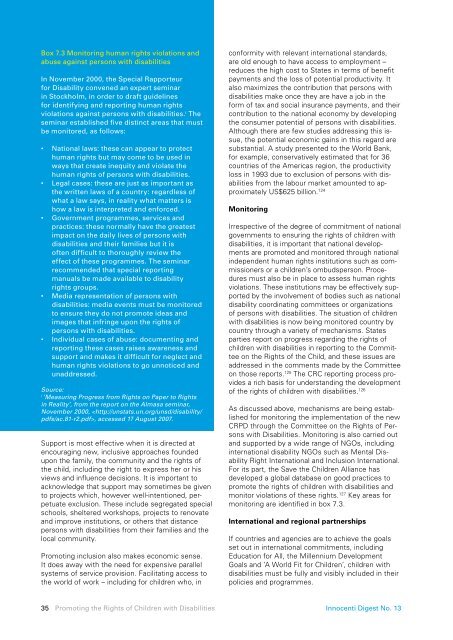Promoting the Rights of Children with Disabilities, UNICEF
Promoting the Rights of Children with Disabilities, UNICEF
Promoting the Rights of Children with Disabilities, UNICEF
- No tags were found...
You also want an ePaper? Increase the reach of your titles
YUMPU automatically turns print PDFs into web optimized ePapers that Google loves.
Box 7.3 Monitoring human rights violations andabuse against persons <strong>with</strong> disabilitiesIn November 2000, <strong>the</strong> Special Rapporteurfor Disability convened an expert seminarin Stockholm, in order to draft guidelinesfor identifying and reporting human rightsviolations against persons <strong>with</strong> disabilities. i Theseminar established five distinct areas that mustbe monitored, as follows:• National laws: <strong>the</strong>se can appear to protecthuman rights but may come to be used inways that create inequity and violate <strong>the</strong>human rights <strong>of</strong> persons <strong>with</strong> disabilities.• Legal cases: <strong>the</strong>se are just as important as<strong>the</strong> written laws <strong>of</strong> a country: regardless <strong>of</strong>what a law says, in reality what matters ishow a law is interpreted and enforced.• Government programmes, services andpractices: <strong>the</strong>se normally have <strong>the</strong> greatestimpact on <strong>the</strong> daily lives <strong>of</strong> persons <strong>with</strong>disabilities and <strong>the</strong>ir families but it is<strong>of</strong>ten difficult to thoroughly review <strong>the</strong>effect <strong>of</strong> <strong>the</strong>se programmes. The seminarrecommended that special reportingmanuals be made available to disabilityrights groups.• Media representation <strong>of</strong> persons <strong>with</strong>disabilities: media events must be monitoredto ensure <strong>the</strong>y do not promote ideas andimages that infringe upon <strong>the</strong> rights <strong>of</strong>persons <strong>with</strong> disabilities.• Individual cases <strong>of</strong> abuse: documenting andreporting <strong>the</strong>se cases raises awareness andsupport and makes it difficult for neglect andhuman rights violations to go unnoticed andunaddressed.Source:i’Measuring Progress from <strong>Rights</strong> on Paper to <strong>Rights</strong>in Reality’, from <strong>the</strong> report on <strong>the</strong> Almasa seminar,November 2000, , accessed 17 August 2007.Support is most effective when it is directed atencouraging new, inclusive approaches foundedupon <strong>the</strong> family, <strong>the</strong> community and <strong>the</strong> rights <strong>of</strong><strong>the</strong> child, including <strong>the</strong> right to express her or hisviews and influence decisions. It is important toacknowledge that support may sometimes be givento projects which, however well-intentioned, perpetuateexclusion. These include segregated specialschools, sheltered workshops, projects to renovateand improve institutions, or o<strong>the</strong>rs that distancepersons <strong>with</strong> disabilities from <strong>the</strong>ir families and <strong>the</strong>local community.<strong>Promoting</strong> inclusion also makes economic sense.It does away <strong>with</strong> <strong>the</strong> need for expensive parallelsystems <strong>of</strong> service provision. Facilitating access to<strong>the</strong> world <strong>of</strong> work – including for children who, inconformity <strong>with</strong> relevant international standards,are old enough to have access to employment –reduces <strong>the</strong> high cost to States in terms <strong>of</strong> benefitpayments and <strong>the</strong> loss <strong>of</strong> potential productivity. Italso maximizes <strong>the</strong> contribution that persons <strong>with</strong>disabilities make once <strong>the</strong>y are have a job in <strong>the</strong>form <strong>of</strong> tax and social insurance payments, and <strong>the</strong>ircontribution to <strong>the</strong> national economy by developing<strong>the</strong> consumer potential <strong>of</strong> persons <strong>with</strong> disabilities.Although <strong>the</strong>re are few studies addressing this issue,<strong>the</strong> potential economic gains in this regard aresubstantial. A study presented to <strong>the</strong> World Bank,for example, conservatively estimated that for 36countries <strong>of</strong> <strong>the</strong> Americas region, <strong>the</strong> productivityloss in 1993 due to exclusion <strong>of</strong> persons <strong>with</strong> disabilitiesfrom <strong>the</strong> labour market amounted to approximatelyUS$625 billion. 124MonitoringIrrespective <strong>of</strong> <strong>the</strong> degree <strong>of</strong> commitment <strong>of</strong> nationalgovernments to ensuring <strong>the</strong> rights <strong>of</strong> children <strong>with</strong>disabilities, it is important that national developmentsare promoted and monitored through nationalindependent human rights institutions such as commissionersor a children’s ombudsperson. Proceduresmust also be in place to assess human rightsviolations. These institutions may be effectively supportedby <strong>the</strong> involvement <strong>of</strong> bodies such as nationaldisability coordinating committees or organizations<strong>of</strong> persons <strong>with</strong> disabilities. The situation <strong>of</strong> children<strong>with</strong> disabilities is now being monitored country bycountry through a variety <strong>of</strong> mechanisms. Statesparties report on progress regarding <strong>the</strong> rights <strong>of</strong>children <strong>with</strong> disabilities in reporting to <strong>the</strong> Committeeon <strong>the</strong> <strong>Rights</strong> <strong>of</strong> <strong>the</strong> Child, and <strong>the</strong>se issues areaddressed in <strong>the</strong> comments made by <strong>the</strong> Committeeon those reports. 125 The CRC reporting process providesa rich basis for understanding <strong>the</strong> development<strong>of</strong> <strong>the</strong> rights <strong>of</strong> children <strong>with</strong> disabilities. 126As discussed above, mechanisms are being establishedfor monitoring <strong>the</strong> implementation <strong>of</strong> <strong>the</strong> newCRPD through <strong>the</strong> Committee on <strong>the</strong> <strong>Rights</strong> <strong>of</strong> Persons<strong>with</strong> <strong>Disabilities</strong>. Monitoring is also carried outand supported by a wide range <strong>of</strong> NGOs, includinginternational disability NGOs such as Mental DisabilityRight International and Inclusion International.For its part, <strong>the</strong> Save <strong>the</strong> <strong>Children</strong> Alliance hasdeveloped a global database on good practices topromote <strong>the</strong> rights <strong>of</strong> children <strong>with</strong> disabilities andmonitor violations <strong>of</strong> <strong>the</strong>se rights. 127 Key areas formonitoring are identified in box 7.3.International and regional partnershipsIf countries and agencies are to achieve <strong>the</strong> goalsset out in international commitments, includingEducation for All, <strong>the</strong> Millennium DevelopmentGoals and ’A World Fit for <strong>Children</strong>’, children <strong>with</strong>disabilities must be fully and visibly included in <strong>the</strong>irpolicies and programmes.35 <strong>Promoting</strong> <strong>the</strong> <strong>Rights</strong> <strong>of</strong> <strong>Children</strong> <strong>with</strong> <strong>Disabilities</strong> Innocenti Digest No. 13
















